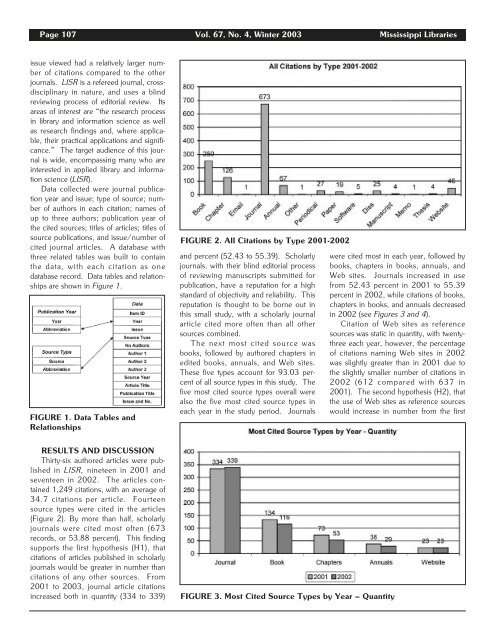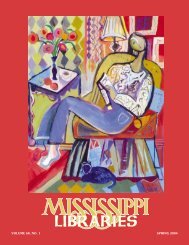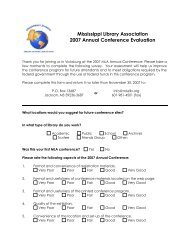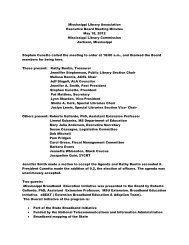Full Text (PDF) - Mississippi Library Association
Full Text (PDF) - Mississippi Library Association
Full Text (PDF) - Mississippi Library Association
Create successful ePaper yourself
Turn your PDF publications into a flip-book with our unique Google optimized e-Paper software.
Page 107 Vol. 67, No. 4, Winter 2003 <strong>Mississippi</strong> Libraries<br />
issue viewed had a relatively larger number<br />
of citations compared to the other<br />
journals. LISR is a refereed journal, crossdisciplinary<br />
in nature, and uses a blind<br />
reviewing process of editorial review. Its<br />
areas of interest are “the research process<br />
in library and information science as well<br />
as research findings and, where applicable,<br />
their practical applications and significance.”<br />
The target audience of this journal<br />
is wide, encompassing many who are<br />
interested in applied library and information<br />
science (LISR).<br />
Data collected were journal publication<br />
year and issue; type of source; number<br />
of authors in each citation; names of<br />
up to three authors; publication year of<br />
the cited sources; titles of articles; titles of<br />
source publications, and issue/number of<br />
cited journal articles. A database with<br />
three related tables was built to contain<br />
the data, with each citation as one<br />
database record. Data tables and relationships<br />
are shown in Figure 1.<br />
FIGURE 1. Data Tables and<br />
Relationships<br />
FIGURE 2. All Citations by Type 2001-2002<br />
and percent (52.43 to 55.39). Scholarly<br />
journals, with their blind editorial process<br />
of reviewing manuscripts submitted for<br />
publication, have a reputation for a high<br />
standard of objectivity and reliability. This<br />
reputation is thought to be borne out in<br />
this small study, with a scholarly journal<br />
article cited more often than all other<br />
sources combined.<br />
The next most cited source was<br />
books, followed by authored chapters in<br />
edited books, annuals, and Web sites.<br />
These five types account for 93.03 percent<br />
of all source types in this study. The<br />
five most cited source types overall were<br />
also the five most cited source types in<br />
each year in the study period. Journals<br />
were cited most in each year, followed by<br />
books, chapters in books, annuals, and<br />
Web sites. Journals increased in use<br />
from 52.43 percent in 2001 to 55.39<br />
percent in 2002, while citations of books,<br />
chapters in books, and annuals decreased<br />
in 2002 (see Figures 3 and 4).<br />
Citation of Web sites as reference<br />
sources was static in quantity, with twentythree<br />
each year, however, the percentage<br />
of citations naming Web sites in 2002<br />
was slightly greater than in 2001 due to<br />
the slightly smaller number of citations in<br />
2002 (612 compared with 637 in<br />
2001). The second hypothesis (H2), that<br />
the use of Web sites as reference sources<br />
would increase in number from the first<br />
RESULTS AND DISCUSSION<br />
Thirty-six authored articles were published<br />
in LISR, nineteen in 2001 and<br />
seventeen in 2002. The articles contained<br />
1,249 citations, with an average of<br />
34.7 citations per article. Fourteen<br />
source types were cited in the articles<br />
(Figure 2). By more than half, scholarly<br />
journals were cited most often (673<br />
records, or 53.88 percent). This finding<br />
supports the first hypothesis (H1), that<br />
citations of articles published in scholarly<br />
journals would be greater in number than<br />
citations of any other sources. From<br />
2001 to 2003, journal article citations<br />
increased both in quantity (334 to 339)<br />
FIGURE 3. Most Cited Source Types by Year – Quantity














